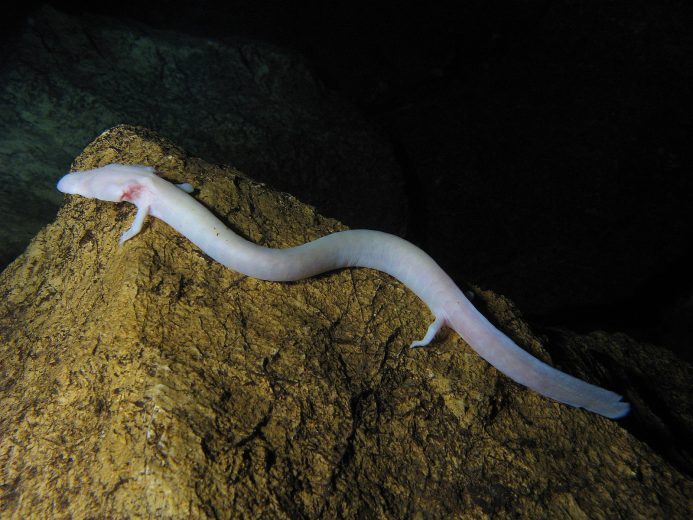Olm (proteus) - Proteus anguinus
Name: Proteus anguinus – olm
Appearance: Its body is elongated, tender and eely, without pigmentation so the body colour comes from the surface capillaries. It is normally yellowish white or rosy white. On the body, one can distinguish pointy head, almost triangular, with a pair of stunted (rudimentary) eyes. On the back of the head, there are three pairs of exterior branched gills. The tail is flattened, curved at the end and bordered with fins, which help them swimming. On the body, there are two pairs of legs. On the front pair, there are three poorly developed toes, and two on the back.
Body length: 23-30 cm
Body weight: 15-20 g
Nutrition: crayfish, earthworms and other invertebrate of the underground waters and caves
Life span: 70 years
Sexual maturity: with 15.6 years
Number of eggs laid: ~70
Olm is an amphibian endemic species of that inhabits underground waters and caves of the Dinaric karst in the coastal part of Slovenia, Croatia and Bosnia and Herzegovina, all the way to Montenegro. However, despite the basic assumptions, its presence in the caves of Montenegro has not been confirmed yet. Since they inhabit underground systems, scientists cannot physically reach them to establish their population, so it remains unknown.
The olms habitats are calm and cold (6-12°C) underground waters rich in oxygen. They can be found on the surface only during heavy rains or after the snow melts when the torrents bring them out on daylight, which normally means death for them.
The first written data about the olm were noted by the Slovenian-Austrian-Hungarian natural scientist J.W von Valvasor in 1689, stating that there was an unusual creature in Slovenia. The people from the surrounding of Postojnska jama (the Pit of Postojna) consider the creatures to be a dragon’s offspring because a warm air coming out of the pit was thought to be dragon’s smoke. However, it was only in 1751 that the Italian doctor and natural scientist G.A. Scopoli managed to obtain the first living specimens of this mysterious animal. Scopoli could not resist to share his enthusiasm with his colleagues from abroad. He sent each of them a specimen in glass jars. During his visit to one of his friends in Klagenfurt, a doctor and zoologist J.N. Laurenti noticed a strange animal in a jar. It was Laurenti who first described the new species naming it Proteus anguinus. He named the genus after the ancient Greek naval god Proteus, son of Poseidon, guardian of Poseidon’s seals and sea beasts, who was known for his ability of fortune telling and transformation into all live beings, water and fire. The species name anguinus, which is Latin for snake, was given after the animal’s body shape. However, Laurenti was not sure where the specimen originated from, so he incorrectly states Cerknica Lake in Slovenia as the species’ place of origin.
Its common name “human fish” comes from the area of Stična, Slovenia most probably given after the similar colour and looks of the animal’s skin with the human’s.
The olm is completely adapted to the life in underground waters and caves – a troglobite. It feeds on crayfish, earthworms and other smaller animals. It finds food through a very well developed sense of smell. Due to its slow metabolism, in the state of rest, it can starve for years. In addition to the sense of smell, its sense of taste is also well developed. On the surface of its body, there are mechanoreceptors, similar to the lateral line in fish, which makes them more sensitive to the water flow.
They breathe through gills and skin and, in hypoxic conditions, through lungs, too.
The olms are very sociable and normally a number of individuals hide on the same place, clinging to each other. During the mating season, a smaller group of males take over a certain amount of space and jointly defend it from other males. The mating begins with the wedding dance of the males, sometimes even without the presence of females. After the wedding dance, the male ejects the spermatophore, which the female accepts with her cloaca.
In the course of development, the olms do not experience full transformation, but the mature individual keeps some of the features of larva, such as exterior gills and tail fin. This feature is marked as neoteny.
According to the IUCN criterion on threatened species, the olm is included in the category of vulnerable species (VU).

